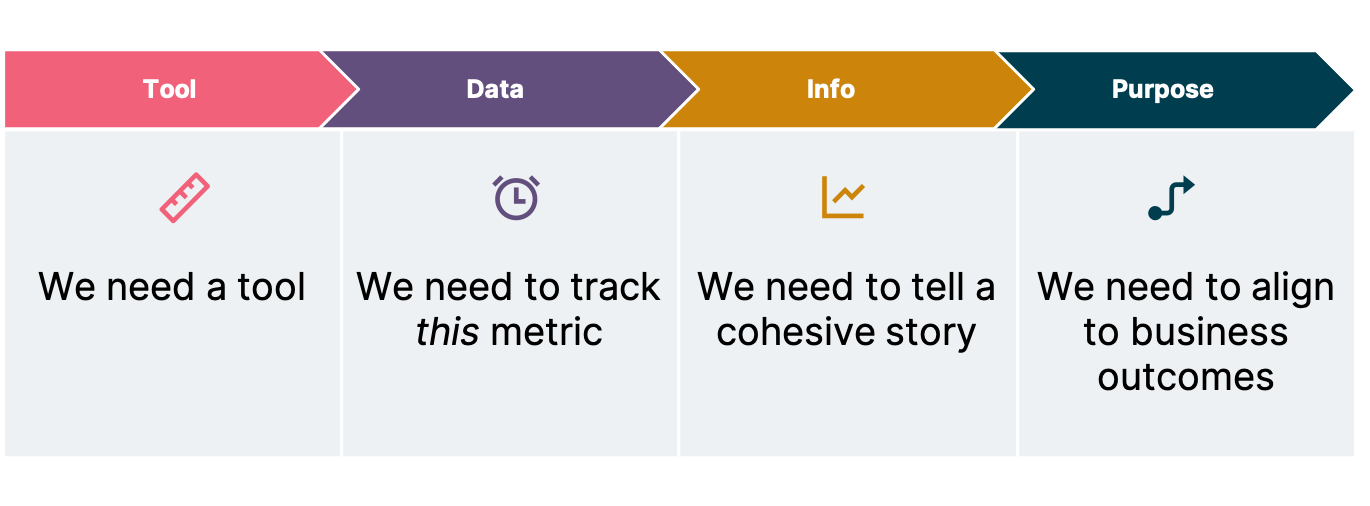
Establishing a clear line of sight between engineering efforts and business outcomes can be challenging. That's where EEBO Metrics (Engineering Excellence to Business Outcome Metrics) come into play. By adopting a maturity model to guide their implementation, tech leaders can leverage EEBO Metrics as a powerful framework for aligning engineering initiatives with tangible business results. Let's explore the four levels of maturity in adopting EEBO Metrics.
"We need a tool"
Aim is to gather data driven by ‘what we can not measure, we can not improve’. Tools that promise capturing lots of data, allow for slicing and dicing for Root Cause Analysis, usually win. This is a tough level to cross as it involves approvals on budget, ownership within org, InfoSec and compliance aspects
"We need to track this metric"
Aim is to identify that right metric that makes the excellence of team evident. This follows with the identification of that right metric that isolates issues beyond the control of the team.
"We need to tell a cohesive story"
Aim is to identify the storyline that’s emerging from the focused subset of metrics. This follows with establishment of excellence of the team or at least their path towards it.
"We need to relate to business outcomes"
Aim is to establish a correlation between improvement towards excellence and improvement in expected business outcomes. This is a tough level to achieve as it involves ingestion of business data, an activity that may not be easy to automate and compliance ask complicating the data flow.
Level 1: Focus on Tool
At the initial stage, the primary focus is on acquiring the right tool for gathering data that drives improvement. The prevailing mindset is, "We need a tool." Organizations recognize that what cannot be measured cannot be improved, making data collection a critical first step. Choosing tools that promise comprehensive data capture and allow for in-depth analysis, such as root cause analysis, tends to be the priority. However, crossing this level poses challenges, as it involves obtaining budget approvals, securing ownership within the organization, and addressing information security and compliance concerns.
Level 2: Focus on Metrics
Once the tools are in place, the focus shifts to defining and tracking relevant metrics. The aim here is to identify the metrics that clearly demonstrate the excellence of the engineering team. Organizations ask themselves, "What metric should we track?" It becomes crucial to identify metrics that not only showcase the team's accomplishments but also isolate factors beyond their control. This level helps establish a solid foundation for measuring progress and identifying areas for improvement.
Level 3: Focus on Narration
With a set of metrics in place, the next step is to weave a coherent and compelling story around them. The emphasis at this stage is on crafting a narrative that emerges from the focused subset of metrics. Teams strive to answer the question, "How do we tell a cohesive story?" The narrative should highlight the journey towards excellence and articulate the team's impact on business outcomes. This level emphasizes the need for effective communication and storytelling skills to convey the value and significance of engineering excellence to stakeholders.
Level 4: Focus on Purpose
At the highest level of maturity, the focus expands beyond engineering excellence to establish a direct correlation between improvement efforts and desired business outcomes. Tech leaders aspire to answer the question, "How do we relate to business outcomes?" This level involves integrating business data with engineering metrics to reveal the impact of engineering initiatives on the organization's overall performance. While achieving this level is challenging, as it requires handling complex data ingestion and compliance considerations, it unlocks a holistic understanding of the value engineering excellence brings to the business.
Embracing EEBO Metrics and progressing through the maturity model outlined above empowers tech leaders to bridge the gap between engineering excellence and business outcomes.
